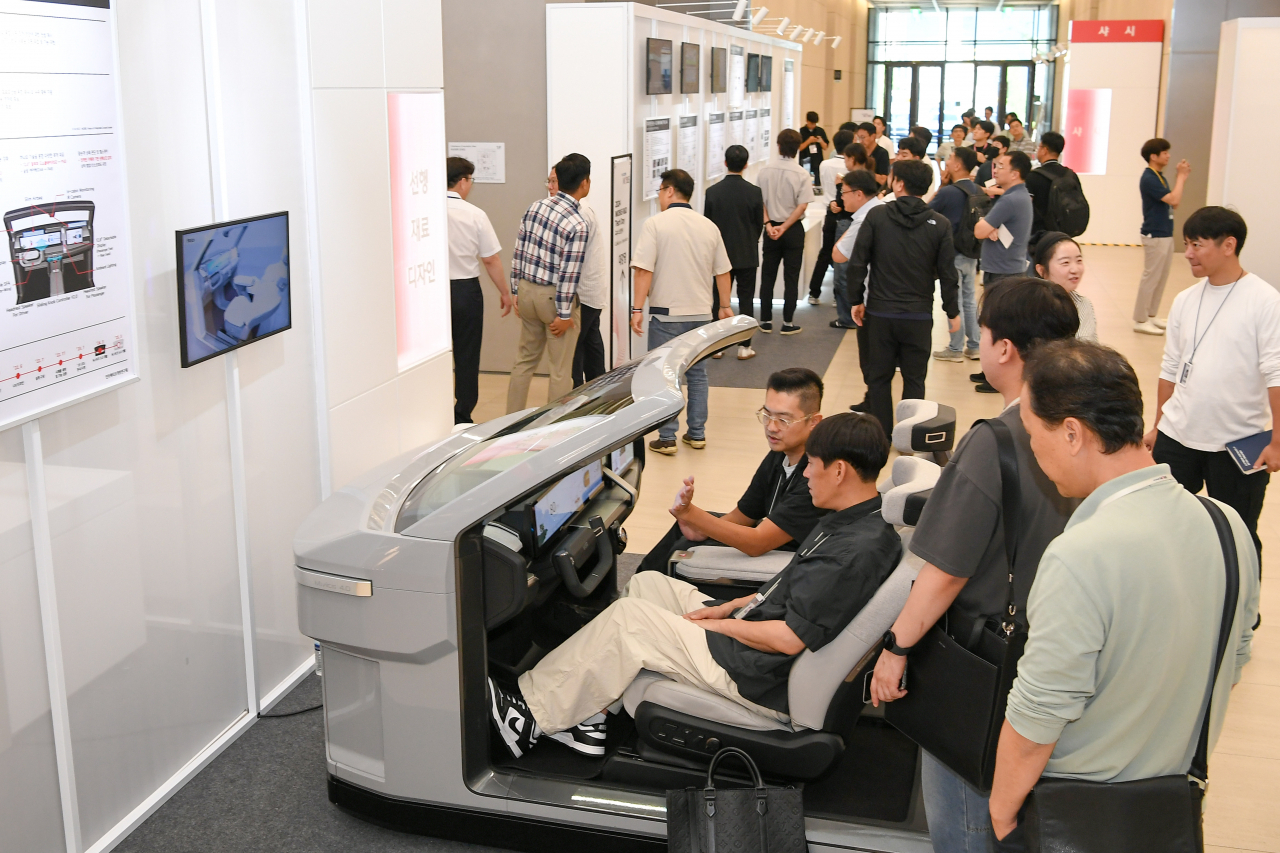
 |
| Visitors listen to a Hyundai Mobis researcher during the 2024 R&D Tech Day held at the Uiwang research center in Gyeonggi Province this week. (Hyundai Mobis) |
UIWANG, Gyeonggi Province – Hyundai Mobis, a car parts manufacturing affiliate of Hyundai Motor Group, on Wednesday opened its electrification research wing to the press in Uiwang, 24 kilometers south of Seoul.
The wing, built as a leading tech center for developing and testing key parts for electric vehicles, was completed in August 2023, and has been in use since December.
With a record-breaking 1.7 trillion won ($1.3 billion) in investment this year alone, the company has introduced 65 new mobility technologies, 15 of which were developed for the first time in the world and are set to be commercialized within the next two to three years.
One of its core technologies is the first-ever EV battery cooling device equipped with a “pulsating heat pipe (PHP),” which consists of tubes with multiple U-turns to cool the heat generated during fast charging.
“Some companies use aluminum plates and extra cooling blocks, but it takes a lot of space and makes a vehicle heavier. Our PHP device solves that problem and ensures a more efficient heat management solution,” said Koo Do-hyun, a senior researcher at the metal electric and electronic car parts materials team at Hyundai Mobis. “It is also 25 percent less expensive than the widely-used photochemical etching process.”
Koo was one of the staff who introduced the exhibition booths, which featured themes such as electrical and electronic parts, modular systems, electrification, chassis, safety and design.
Another pioneering technology involves an airbag system that analyzes a passenger’s seated position and deploys the airbag accordingly. Kim Dong-young, a senior researcher on the airbag design team at Hyundai Mobis, said that the new model stays inflated longer when passengers are sitting back in a tilted position, to account for the extra time it takes for them to hit the airbag in a crash.
The company also showcased a concept car called “M.VICS 4.0,” which boasts enhanced convenience and safety features for autonomous driving. It can perform health assessments, such as heartbeat monitoring, and automatically adjust the seats and sound for theater mode, relax mode or other settings based on the driver’s choice.
 |
| Lee Young-kook, head of the automation engineering division at Hyundai Mobis speaks during a press conference held at the company’s research center in Uiwang, Gyeonggi Province on Tuesday. (Hyundai Mobis) |
Pushing forward technological innovations for air mobility and robotics as well as cars, the company presented development strategies for battery, driving and power conversion systems on the same day.
“We plan to adopt a ‘cell-to-pack’ system instead of the existing ‘cell-module-pack’ to expand energy density and capacity of EV batteries,” said Lee Young-kook, head of the automation engineering division at Hyundai Mobis during a press conference. The approach would skip the intermediate stage of arranging battery cells into modules before making the "pack" or overall battery.
“Also, to prevent EV fires, which has alarmed the public lately, we are developing technologies that can prevent defects of individual cells from affecting the entire battery system.”
Lee added that the company’s strategy is in line with Hyundai Motor Group’s recent announcement to increase monitoring hours of its battery management system to better address fire risks.
As for driving systems, it will enhance its all-in-one vehicle control unit, motor and brake system to better align with modular design concepts, making them more flexible and feasible for competitively priced mass production, according to Lee.
The power conversion system, which converts energy stored in the batteries to power the vehicle, includes next-generation integrated charging control units (ICCU) with a low-voltage DC-DC converter -- an essential component for faster and more efficient EV charging.
The company has also applied for certification of its “vehicle-to-grid” technology in several countries. It enables plug-in electric vehicles to inject electricity into the power grid and sell extra electricity to power plants.
Seeking a bigger presence overseas, Hyundai Mobis is currently setting up seven production bases for electrification – one of them in Slovakia with a projected annual capacity of electric car parts for 300,000 EVs.
Highlighting the growing interest from global carmakers, Lee stated, “OEMs from Japan, Volkswagen and Mercedes-Benz recently visited our exhibition. During the Consumer Electronics Show 2024, we met with C-level executives including Mercedes-Benz CEO, General Motors official and research and development head of Stellantis.”
Lee added that German clients are particularly interested in the firm’s battery system, while European and Japanese carmakers are each keen on its driving system and ICCU.









